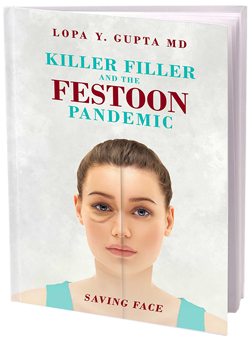With the plethora of collagen-building, minimal down time anti-aging treatments at our disposal, the onus is on the cosmetic facial surgeon to learn, master, and offer these exciting modalities to his or her patients. With such treatments, our goal as surgeons is to triangulate, sculpt, and tone the aging face which tends to get square, bottom-heavy, and lax with loss of collagen and youthful volume. To replenish lost volume and attain a natural look, I am of the opinion that only modest amounts of filler ought to be used—to avoid the “stuffed and puffed” look of “killer filler.” Unfortunately, too many patients have succumbed to aggressive filler injections with devastating aesthetic outcomes—not realizing that filler builds up with time and fat grafts can lead to chronic swelling issues.
Here are some mistakes I commonly see and revise:
1. Overzealous and serial injections of hyaluronic acid (HA) fillers like Voluma, Juvederm, Restylane and autologous fat grafts
- in the under eye and cheek area: possible result is a poofy look with festoons months or years later
- in the central third of the face (lips, nasolabial folds, marionette lines): possible result is a chipmunk look with duck lips
- in the jawline: possible result is a square, bottom-heavy look that aids gravity
2. Overdosing Botox or Dysport treatments
- to the forehead: possible result is a frozen look with dropped eyebrows and hooded lids
- to the crow’s feet: possible result is increased fluid in patients with excessive HA fillers/fat grafts or frank festoons. Botox/Dysport debilitate the orbicularis oculi muscle that pumps fluid out of the eyelid/cheeks.
Sculptra or Silicone nodules
- possible result is nodules that surface after “hot” treatments like laser resurfacing






